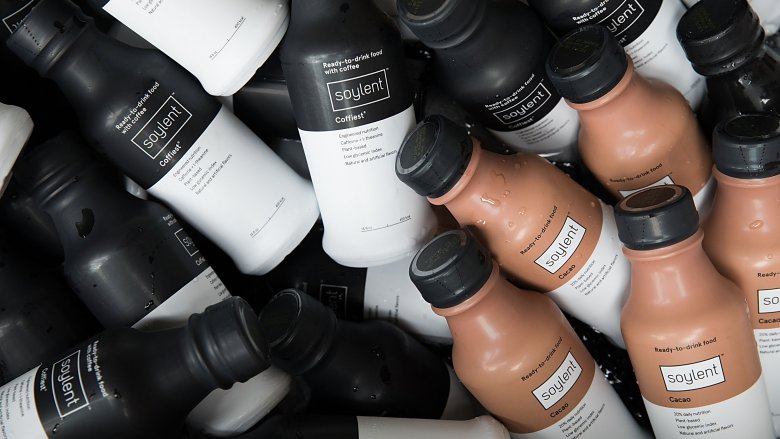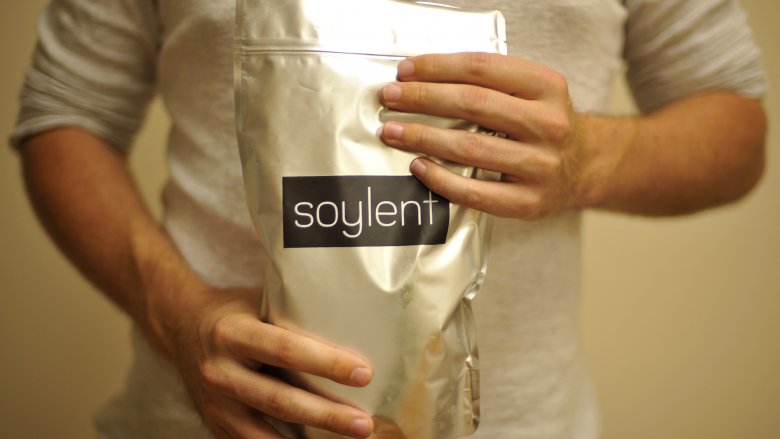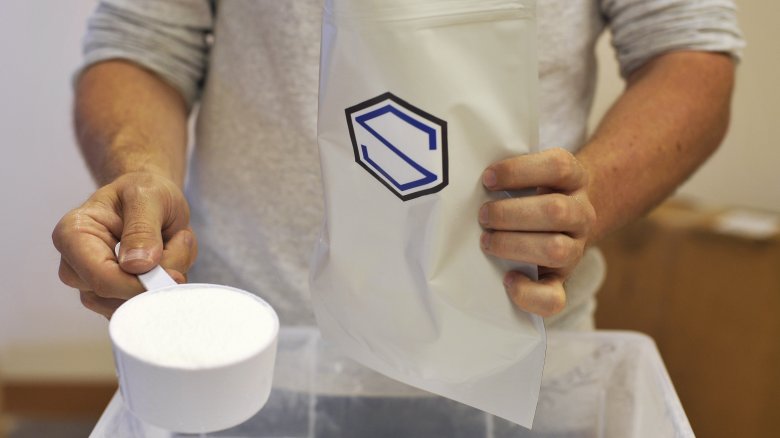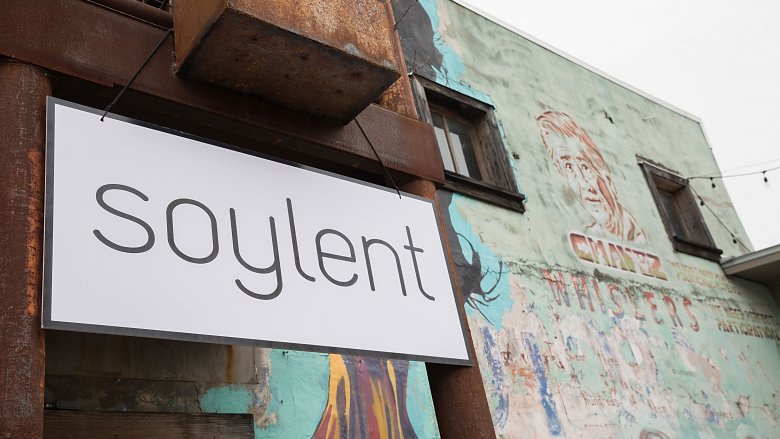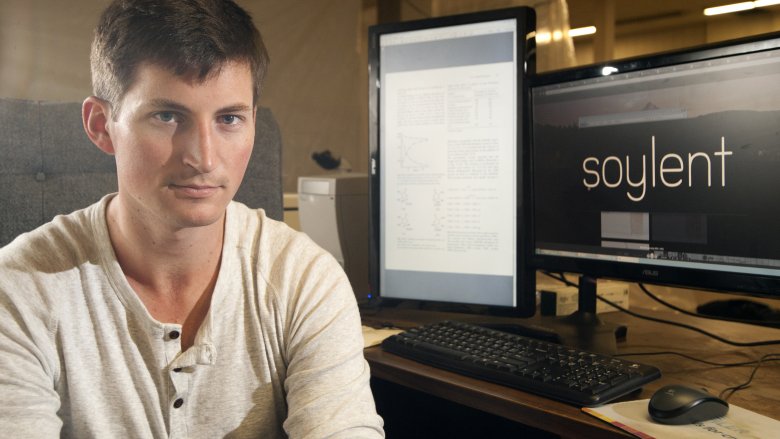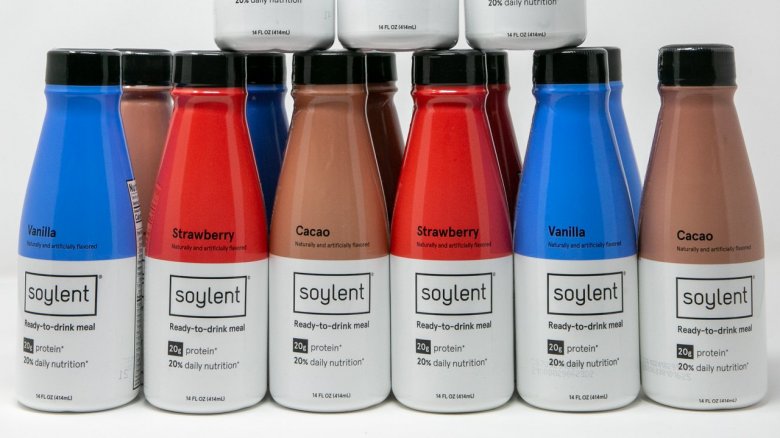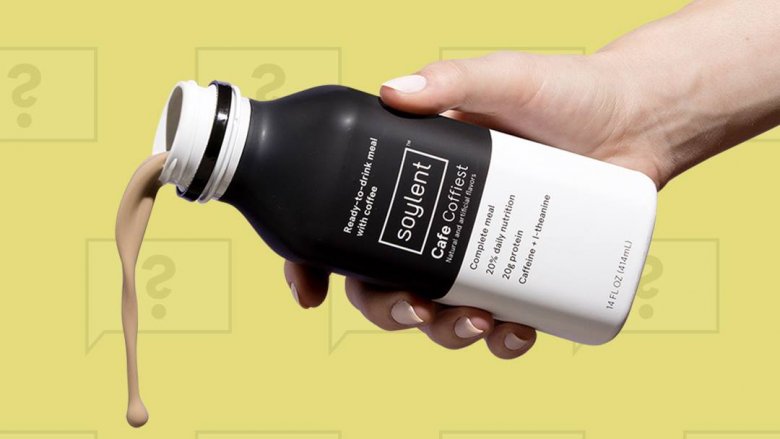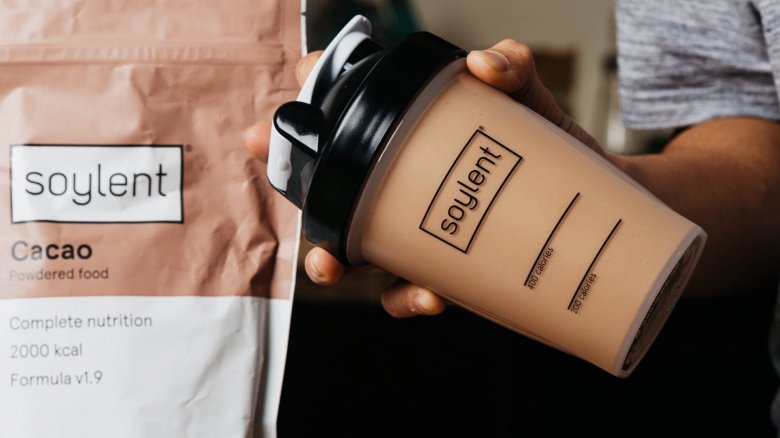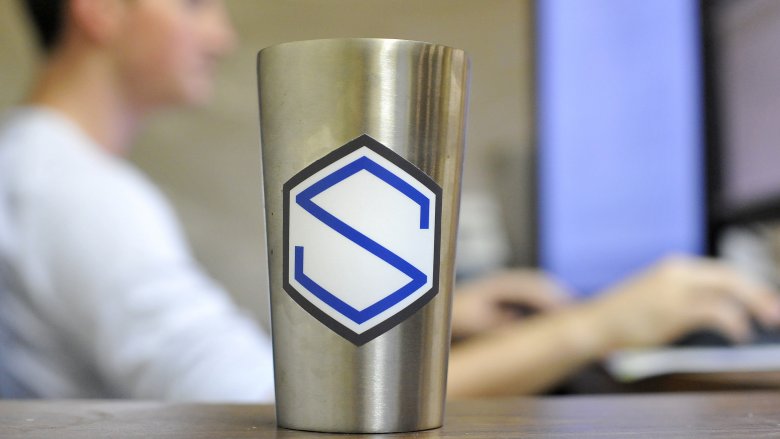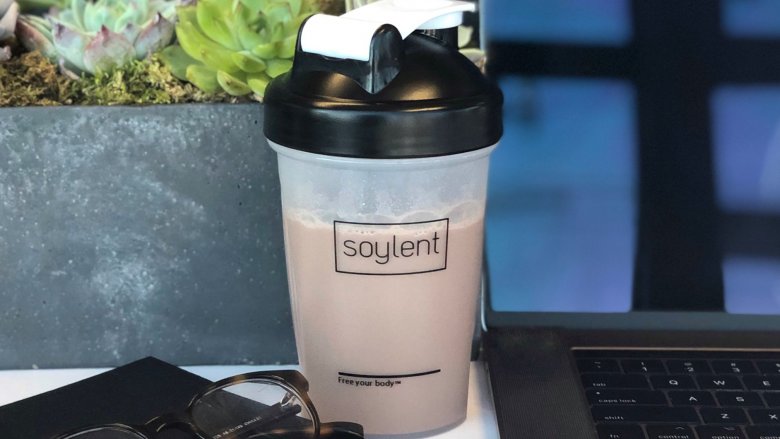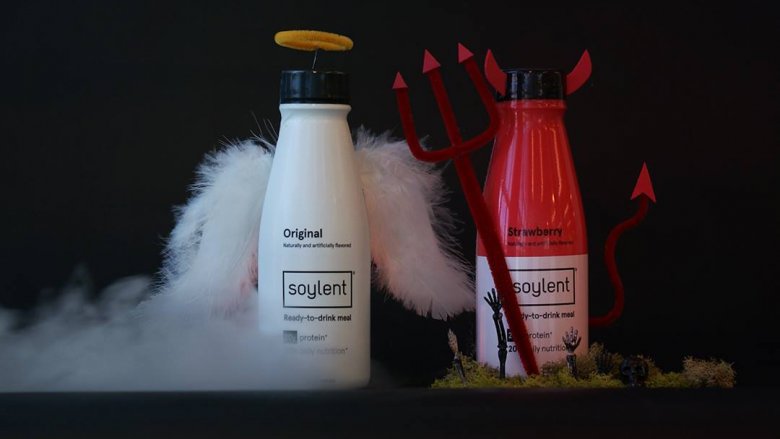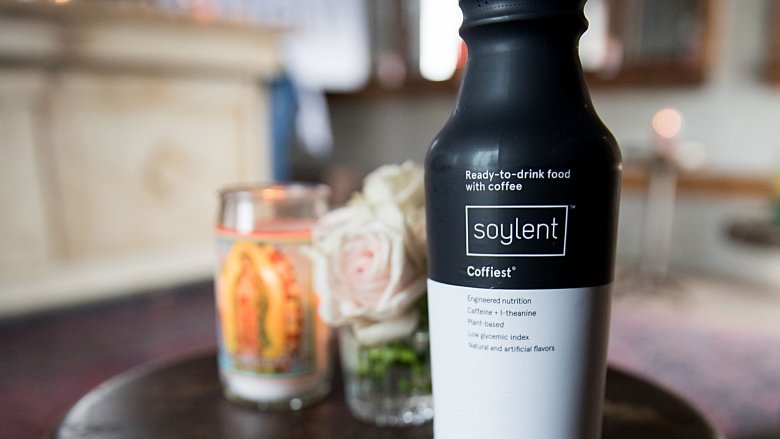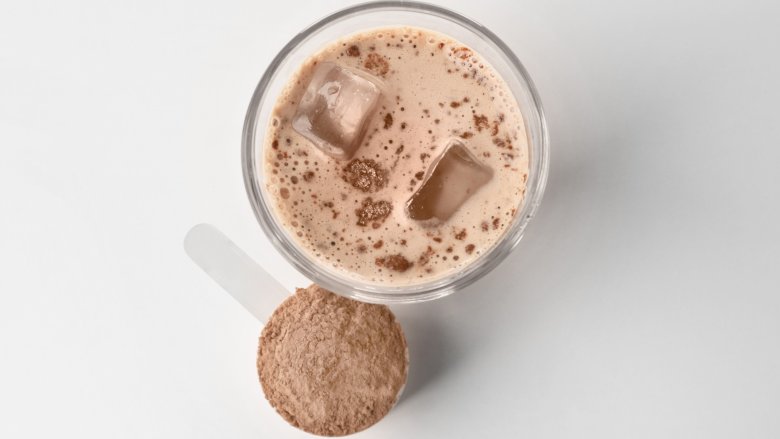The Untold Truth Of Soylent Meal Replacement Drinks
It's no secret that no matter who you are or what you do, life is busy. It's tough to fit everything in to the fairly limited hours in the day, so shortcuts and life hacks are always welcome — especially when they work. But what about all the time you spend doing food-related activities?
That's not just eating, that's also cooking, grocery shopping, planning meals, putting food away, packaging up leftovers, packing lunches, washing dishes... it adds up to a lot of time. Soylent meal replacement shakes were designed to skip all that, and give your body everything it needs to thrive: no more, no less, and all in a convenient shake that takes no time at all to prep and drink.
The wave of the future, maybe, but here's the question: are we talking about an ultra-healthy utopia, or an ultra-repetitive, dull, dystopia? Does it depend on the person? It's fascinating to think about whether or not food — and all the social aspects that surround it — will be replaced by a super-practical drink. That's a discussion the world is going to have to have at some point, but in the meantime, let's take a look at the truth behind Soylent drinks.
What exactly is in them?
Soylent, they say, was formulated to provide all necessary nutrition in an easy-to-consume format. What does that mean, exactly? And what are you drinking when you chug one?
Healthline took a closer look at the contents of the drink, and found that one of the major components is something pretty common: soy protein isolate. It's a complete protein — which means it has all the essential amino acids you need — and since it's plant-based, it's popular among vegetarians and vegans. There have been a ton of studies done on just how effective the protein is, and Healthline says there are a lot of good things about it. It can help you build muscle, and lose weight, but it's not entirely perfect. It can potentially decrease your body's ability to absorb minerals, and it's possible it could negatively impact thyroid function for some (although studies aren't conclusive).
Another main ingredient is high oleic sunflower oil, which has been linked to lowering risk factors for heart disease, and isomaltulose, which is essentially a carbohydrate made up of two sugars that absorbs slowly into the body. It's then fortified with vitamins and minerals (like vitamin B6 and B12, iodine, zinc, copper, and riboflavin) so that every drink contains 20 percent of what you need to remain a functional human being.
It was all about the chemical components
The mastermind behinding Soylent is Rob Rhinehart, and he's not a nutritional guru — he's a tech guy who thought there had to be a better, more affordable way to get all the nutrition he needed without the pesky hassle that went along with food.
That's when he started looking at food like it was something to be engineered. "You need amino acids and lipids, not milk itself," he told The New Yorker. "You need carbohydrates, not bread. ... It just seemed like a system that's too complex and too expensive and too fragile."
So, started hitting the books and the internet to figure out exactly what base nutrients humans need to survive. From there, he ordered powders and pills, mixed them into a slurry, and starting consuming only this new creation he called Soylent.
It took a little experimentation, and Rhinehart was the guinea pig — but soon he became a walking advertisement for it, writing, "I feel like the six million dollar man. My physique has noticeably improved, my skin is clearer, my teeth whiter, my hair thicker and my dandruff gone. ... I haven't eaten a bite of food in thirty days, and it's changed my life."
The name has been used before
If the name Soylent sounds familiar, there's a good reason for that. It was perhaps most famous for being the form of sustenance in the movie Soylent Green, which starred Charlton Heston and ended with (spoiler alert) the horrifying reveal that the wafers were actually made from human remains.
That's not exactly where the name came from, and Rhinehart told The New Yorker that he had actually chosen it because of the book the film was based on. Make Room! Make Room! was, indeed, the tale of overpopulation in a dystopian future, but the Soylent in the book was simply made from soybeans and lentils.
And yes, Rhinehart has said that many, many people — from investors to media to mothers — suggested calling the product pretty much anything but Soylent. But he didn't, saying he liked the way it had a sort of anti-foodie connotation that took a jab at what most of us think is food.
Here's why Soylent's creator thinks it's uber healthy
Perhaps unsurprisingly, Soylent's creator has some very non-traditional ideas about food. He told The Atlantic that he started to think the whole idea of food was a little odd when he was around 6 years old, and realized his mother was serving the same things that grew on trees outside. "It seemed a little primitive — like something an animal would do," he said.
The belief system Soylent was based on is one that's fairly opposite to what most food-eaters believe, and that's the idea that "Natural isn't always best." Rhinehart says it starts from birth, and firmly believes that formula is a better option than breast milk, because of "safety control and completeness" reasons.
He says we mostly like natural and unprocessed foods because of "an emotional attachment to culture and tradition", and has a whole list of reasons Soylent is better than other types of what he calls "recreational food" (i.e., anything that isn't Soylent). Fresh food, for example, isn't nearly as good as you might think (Rhinehart says). "... nutritionally speaking, canned vegetables are better than fresh ones because fresh ones are decaying. ... So it seems kind of backwards, I think, actually, to go for fresh. Why are these foods seen as healthy?"
Instead of being grown in a ground potentially contaminated by things like lead and arsenic, his reasoning goes, Soylent comes perfectly prepared from a lab — and that makes it better.
So, what about the taste?
Soylent comes in a few flavors, as of April 2019: Original, Strawberry, Vanilla, and Cacao (as well as the Soylent Cafe varieties that we'll talk about later). How on earth is Vanilla not the same as Original, you might be asking, and what does Original taste like, then? According to The New Yorker, it's been described mainly as a variation of "Cream of Wheat" to "my grandpa's Metamucil." Not a glowing recommendation by any means, and certainly one that doesn't sound like it's going to replace your Friday night pizza.
But Soylent is meant to replace entire meals for days on end, so what does that do to your taste buds?
Wired's Katia Moskvitch tried switching to meal replacement drinks Soylent and UK-based competitor Huel for an entire month, and described the feeling as "taste fatigue." After just a few weeks, Moskvitch wrote: "I just couldn't take it anymore."
And she wasn't alone, either. The sheer monotony of nothing but the taste and texture of Soylent is enough to make people obsess over real food. When one reporter for The Independent tried living on Soylent for just a single week, she found herself craving actual food, to the point where it was difficult to think of anything else. She also said it was completely a texture thing, and that she was surprised how much she missed actually chewing.
Yes, there are side effects
When a reporter for The Independent tried to go Soylent-only for just a week, she found there were some side effects, both physical and mental. Not only did she miss the physical act of eating, but she found herself missing out on the social aspects of it, too. When friends and coworkers went out for lunch, she had her drink. When appetizers were served at a black-tie event, she was left just to look at them... and crave solid food. At first, finding other things to do with friends aside from going out to eat was a bonus, but it got old very, very quickly.
Choice? Gone. Enjoying a meal? Gone.
But what about physical side effects? There are those, too — and those include gastrointestinal distress, diarrhea, and flatulence that's described by some people as extreme. According to Healthline, Soylent is still new enough that evidence of side effects — that also include a significant decrease in bowel movement frequency — is anecdotal. For some of those who have tried it, they say it's not.
Why some nutritionists don't recommend it
So, how about Soylent's claims to contain everything anyone needs to be a functional human being, all in one bottle? Nutritionists are cautious.
London-based nutrition expert Fiona Lawson told Wired that anyone wanting to have that kind of control over their food was better off making their own smoothies, for one simple reason: it included actual food. "We don't yet know all the vitamins, minerals, phytonutrients and other substances that make up whole, natural food — so how can we possibly create it?"
And it's a valid point that Berkeley Wellness agrees with. Just because we know what vitamins we need, that doesn't mean we know how they work once we take them.
Other nutritionists, like Daniel O'Shaughnessy from the British Association for Nutrition and Lifestyle Medicine, say that while Soylent might contain all the minerals and nutrients your body needs, that doesn't mean they're in a form you can easily absorb. Stacey Lockyer from the British Nutrition Foundation suggests the only real, safe way to consume it is if you're using as an alternative to high-sugar, high-fat snacks.
But it's still better than what most Americans eat
While nutritionists might hesitate at the idea of replacing real food with Soylent, The Atlantic says there's something else that needs to be taken into consideration: Soylent, for all its flaws and questions, is still better than the standard diet of a normal American.
The amount of added sugar most Americans eat is astronomical. Healthline says the average person has 76.7 grams of sugar per day, which is about 19 teaspoons. That's way more than the recommended amounts: 37.5 grams for men, 25 grams for women. Eating so much junk food and empty calories has created a bizarre phenomenon, and that's the fact that many, many people are both overweight and malnourished.
So, it goes to reason that if you're eating a lot of garbage, switching to Soylent might do some real good. But does that mean that Soylent is amazing, or that the everyday diets of the majority of Americans is so horrible, it's doing untold damage?
The lack of color is a big deal
Everyone loves the look of a colorful plate of food. We might think first of posting on social media or Instagram, but those colors are actually extremely important — and that means it's a problem that Soylent isn't just lacking in color, but in all the benefits that go along with the rainbow of food.
Take tomatoes. Their red color comes from something called lycopene, which doesn't just make them red, but it's also been linked to lowering the chances of developing prostate cancer. You can say the same of blueberries. They're blue because of flavonoid compounds, and those same compounds have been found to lower your risk of developing diabetes.
When The New Yorker pointed this out to Rhinehart, he scoffed. He had looked into the evidence and had considered adding some of these phytochemicals, but thought the research wasn't conclusive enough to justify adding them to the recipe. After all, he asked: "How many humans in history were even getting broccoli and tomatoes?"
It was banned in Canada
According to The Globe and Mail, Soylent hit shelves in Canada in June 2015. However, by October 2017, they were reporting that Soylent would no longer be for sale.
Why? According to a letter from Rhinehart, the Canadian Food Inspection Agency had determined that Soylent didn't meet all the nutritional guidelines put in place for a product to be considered a "meal replacement" in Canada. Details were vague, but there were promises to share more in the future.
The letter wasn't updated, but according to The Globe and Mail, there was no recall in place and nothing was deemed a health risk. They also said the CFIA wasn't able to share just how Soylent deviated from their guidelines, but they also noted that — shockingly — those guidelines hadn't been updated since the 1990s. Nutritionists suggested it would probably be a good idea for those guidelines to go under review, but whether or not that would have changed the ruling on Soylent, it's impossible to say.
It's made people violently ill
There are side effects... and then there are side effects on the scale of full-blown food poisoning. It was that latter that had people suffering in 2016, when The Guardian reported a huge number of people were getting violently ill after eating Soylent's 250-calorie food bars that had been released just a few months prior. For some, the food poisoning-grade illness was so bad they ended up going to the hospital, and it was widespread enough that the company issued a statement telling people to throw away any of the bars that remained uneaten. Sales stopped, and they tried to figure out what had gone wrong.
Soylent sent an official statement to Gizmodo, saying that not only had they received complaints on less than .03 percent of the bars sold, but that microbiological testing had come back clean, and they had personally eaten plenty of the bars in the batches reported to have been making people sick without suffering any ill effects themselves.
Their suggestion? The people who got sick likely had "an allergy, intolerance, or sensitivity to ingredients" and should get in touch with their doctor before eating more of the product.
Then, there's Coffiest
There's Soylent and then there's Soylent Coffiest, a drink with both caffeine and something called L-theanine. What's L-theanine? According to Soylent, it's a compound found in tea leaves that boosts the effectiveness of caffeine at the same time it lessens some of caffeine's more undesirable side effects.
Sounds great, but does it work?
Medical News Today is cautious, saying there are studies out there that have supported the idea L-theanine helps boost mental focus, improve sleep quality, improve brain function, boost the immune system, lower blood pressure, and aid in weight loss. There's a big "but" here, and that's basically that a lot of that evidence comes from studies done on animals, not on humans. They also say that results in humans are likely to vary, and add that L-theanine has the potential to interact with some medications, particularly those taken for blood pressure regulation and the treatment of ADHD. That's an important detail, and they recommend speaking with a doctor before taking anything with L-theanine.
It's not that different from other meal replacement drinks
Soylent might have a reputation for being futuristic, cutting edge, and somehow better because it's right out of Silicon Valley, but when Lifehacker compared it to some of the other meal replacement drinks out there, they found that it's not too much different.
Take Ensure. Ensure actually has more vitamins and minerals, but it also has about twice the sugar — and that's where Soylent has a massive advantage. But there are other options out there that are also sugar-free, like Light Fuel. Athlete Fuel has a whole list of defining features, and like Soylent, it's also vegan. Then, there's Schmilk, which is made from oat flour instead of soy.
Bottom line? They're all a little different, and there are plenty of choices out there if you're looking to go the meal replacement drink route for at least some of your meals. But the science is still out on whether or not replacing every meal with a drink is a good idea... or if it should just be left in the pages of science fiction.
